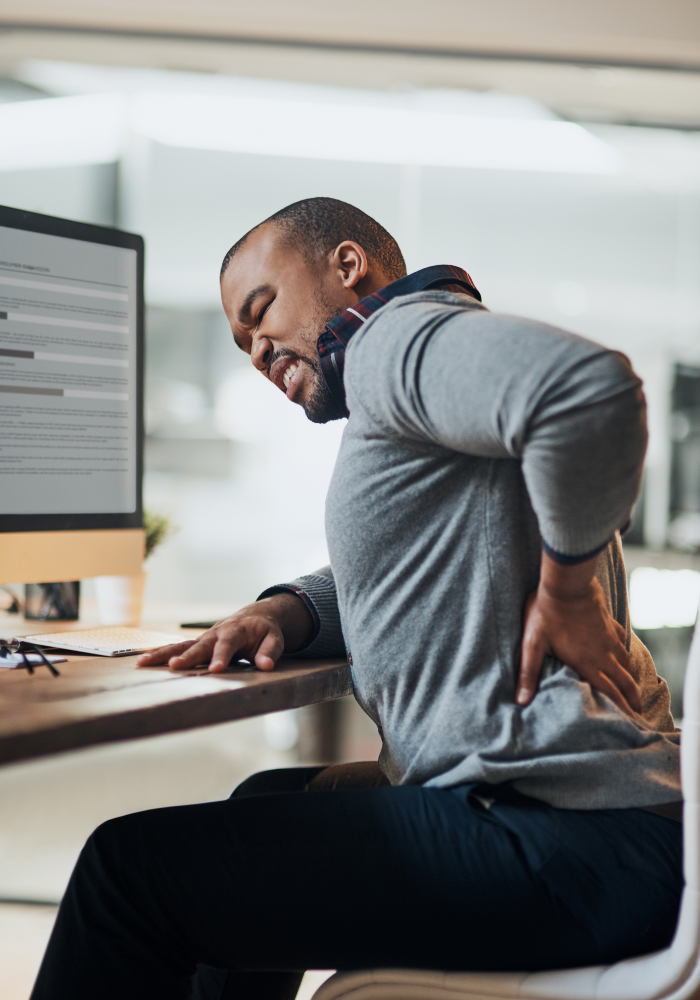Perhaps the single most common medical complaint physicians hear is back pain. Medical professionals predict that 80% of the US population will experience back pain at some point in their lives. This is not surprising as nearly half of the working population in America admits to experiencing regular back pain each year (source). Back pain manifests in a variety of different ways and has a multitude of underlying causes and associated risk factors.
Back pain can be described as a persistent dull ache, as a recurring sharp pain, or a combination of the two. Back pain can also be localized to a small and specific region of the back, focused in various spots, radiate out to the extremities, or generalized across the length of the spine. In addition to pain, backaches are also commonly associated with general weakness, lethargy, headaches, irritability and potential nerve-damage.
While people of all walks of life can experience back pain, certain individuals are more prone to back pain symptoms. Older individuals may be more prone to injury and aches as a result of natural wear and tear. Athletes and people who regularly exercise and exert themselves will expose their backs to regular aches and potential injuries. Commuters and regular drivers are also at risk of a car-accident injury, which can frequently manifest as back pain, herniated discs and spine injuries.
Common Causes of Back Pain In Athletes
Back is extremely common, making diagnosing back pain relatively easy for physicians and chiropractors. With regular experience treating back pain patients, especially athletes, doctors may be able to diagnose the patient’s condition with a simple physical exam. If further testing is needed, the doctor may order an MRI, CT Scan or X-Ray to receive an inside look of the musculoskeletal system and surrounding soft tissue.
- Musculoligamentous Strain – This occurs when the soft tissue within the back becomes injured, strained or sprained through blunt trauma or overuse.
- Spondylolysis – This condition refers to the appearance of stress fractures along the structures of the vertebral arches. These types of injuries are most common along the lumbar, or lower back, vertebrae. Athletes who are active in sports such as gymnastics, track & field, or football are most likely to develop spondylolysis.
- Spondylolisthesis – This condition occurs if a disc slips or becomes displaced from the natural alignment of the spine.
- Herniated Nucleus Pulposus – When the nucleus pulposus, or the soft jellylike interior of the vertebral discs, bulges outside the bony protection of the vertebra, it is said to be herniated. Herniated nuclei are very painful and can cause a significant reduction in the patient’s quality of life.
Treatment For Back Pain
Typically, back pain can be treated non-surgically with a conservative or active approach. These methods include:
- Non-steroidal-anti-inflammatory medications in conjunction with analgesics
- Cold and heat therapy can be useful in reducing pain, discomfort, and swelling (if present)
- Posture evaluation and ergonomic suggestions and corrections
- Chiropractic manipulation and adjustments
- Medical massages
- Physical therapy
- Rest
Having both a healthy back and spine is imperative to sustain a happy and active life. Back pain can quickly become chronic and debilitating. If back pain begins to impact the spine, it can lead to nerve damage and disabling paralysis. To treat more severe cases of back and spine injuries, surgery can be utilized. Surgical approaches to back pain will commonly focus on relieving pressure from the spine.



